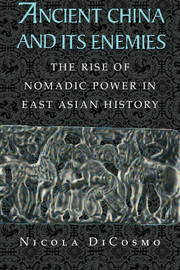Book contents
- Frontmatter
- Contents
- Acknowledgments
- Introduction
- Part I
- Part II
- 3 Beasts and Birds: The Historical Context of Early Chinese Perceptions of the Northern Peoples
- 4 Walls and Horses: The Beginning of Historical Contacts between Horse-Riding Nomads and Chinese States
- Part III
- Part IV
- Conclusion
- Glossary
- Select Bibliography
- Index
3 - Beasts and Birds: The Historical Context of Early Chinese Perceptions of the Northern Peoples
Published online by Cambridge University Press: 25 August 2009
- Frontmatter
- Contents
- Acknowledgments
- Introduction
- Part I
- Part II
- 3 Beasts and Birds: The Historical Context of Early Chinese Perceptions of the Northern Peoples
- 4 Walls and Horses: The Beginning of Historical Contacts between Horse-Riding Nomads and Chinese States
- Part III
- Part IV
- Conclusion
- Glossary
- Select Bibliography
- Index
Summary
Introduction
Is it true that, during the Spring and Autumn period, a clear consciousness emerged of a moral and cultural divide between the Chou states and a nebulous external world of alien peoples? Several passages in the Ch'un ch'iu and its commentaries, which later entered the Shih chi and other historical works, show foreigners being compared to animals and being represented as subhuman. A certain mythology of the external world and an idealized representation of geographic space in terms of its moral and political order contribute to the impression that, during the Chou period, a notion of “China” as a territory – Chou states, chung-kuo – and of “the Chinese” as a people – Hua or Hsia – crystallized sufficiently to make China's external boundaries deeper than internal boundaries between the various polities that comprised the Chou political and cultural universe. The evolution of an inner Chinese core differentiated from an outer non-Chinese one was already seen by Fu Ssu-nien in the opposition between the mythical Hsia dynasty and the so-called Yi peoples. Nonetheless, although both the Shang and the Western Chou fought against foreign polities, the few dry records of their expeditions, triumphs, and defeats fail to convey a clear sense of this differentiation between a “Chinese” world of shared principles, revolving around a real or assumed source of moral and political authority (the Chou dynastic line), and a “barbarian” world whose inhabitants were placed at various degrees of distance from that central source.
- Type
- Chapter
- Information
- Ancient China and its EnemiesThe Rise of Nomadic Power in East Asian History, pp. 93 - 126Publisher: Cambridge University PressPrint publication year: 2002
- 1
- Cited by



